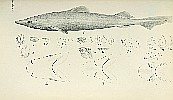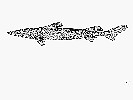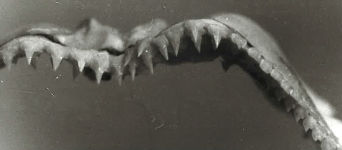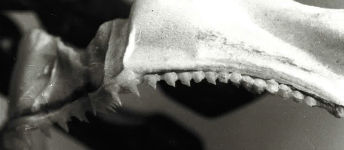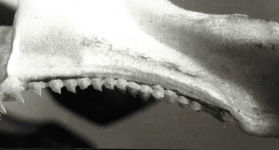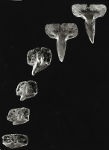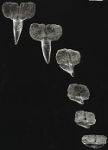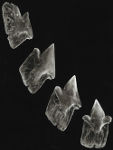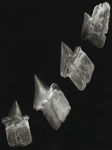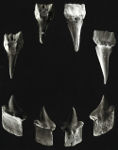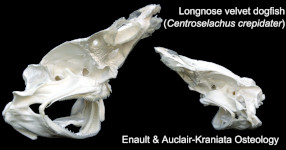Centroselachus crepidater
(Barbosa Du Bocage & De Brito Capello, 1864)
Longnose velvet dogfish
Classification: Elasmobranchii Squaliformes Somniosidae
Reference of the original description
Sur quelques espèces inédites de Squalidae de la tribu Acanthiana Gray, qui fréquentent les côtes du Portugal. Proceedings of the Zoological Society of London, 1864, 260–263
Sur quelques espèces inédites de Squalidae de la tribu Acanthiana Gray, qui fréquentent les côtes du Portugal. Proceedings of the Zoological Society of London, 1864, 260–263
Image of the original description
.jpg)
Centrophorus crepidater Barbosa du Bocage & de Brito Capello, 1864 valid as: Centroselachus crepidater (Barbosa du Bocage & de Brito Capello, 1864)
.jpg)
Centrophorus crepidater Barbosa du Bocage & de Brito Capello, 1864 valid as: Centroselachus crepidater (Barbosa du Bocage & de Brito Capello, 1864)
Synonyms / new combinations and misspellings
Centrophorus crepidater, Centrophorus jonssonii, Centrophorus rossi, Centroscymnus cf. crepidater, Centroscymnus crepidater, Centroscymnus crepidator, Centroscymnus furvescens, Centroscymnus rossi, Lepidorhinus rossi
Centrophorus crepidater, Centrophorus jonssonii, Centrophorus rossi, Centroscymnus cf. crepidater, Centroscymnus crepidater, Centroscymnus crepidator, Centroscymnus furvescens, Centroscymnus rossi, Lepidorhinus rossi
Types
Centroselachus crepidater
Holotype: MB: T.112(49) (destroyed)
Centrophorus jonssonii
Syntype: NHMR: ?
Centrophorus rossi
Holotype: ZSI: F225/1
Centroselachus crepidater
Holotype: MB: T.112(49) (destroyed)
Centrophorus jonssonii
Syntype: NHMR: ?
Centrophorus rossi
Holotype: ZSI: F225/1
Description :
Citation: Centroselachus crepidater (Barbosa Du Bocage & De Brito Capello, 1864): In: Database of modern sharks, rays and chimaeras, www.shark-references.com, World Wide Web electronic publication, Version 12/2025
Please send your images of "Centroselachus crepidater" to info@shark-references.com
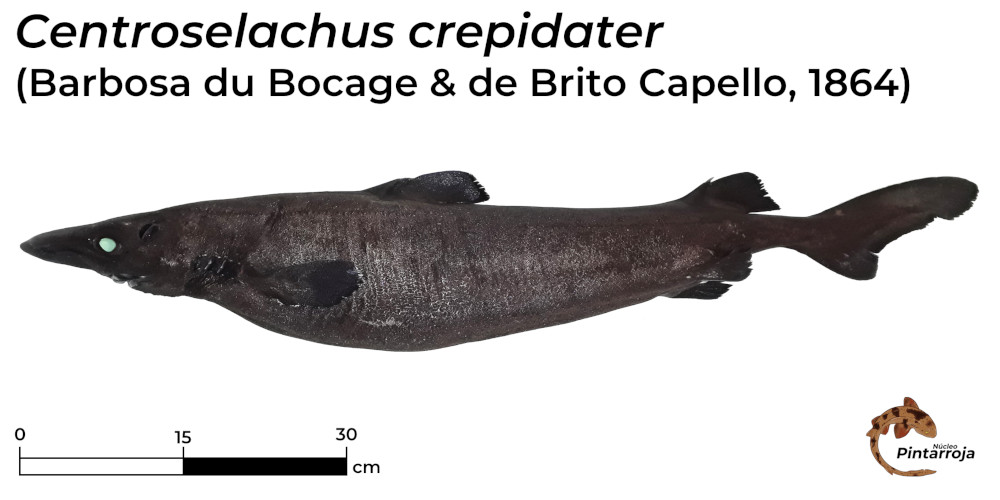
Centroselachus crepidater (Barbosa du Bocage & de Brito Capello, 1864), Chile © L. Ignacio Contreras, Laboratorio de Zoología de Vertebrados, Facultad de Ciencias, U. de Chile

Centroselachus crepidater (Barbosa du Bocage & de Brito Capello, 1864), Chile © L. Ignacio Contreras, Laboratorio de Zoología de Vertebrados, Facultad de Ciencias, U. de Chile
Common names
 Langschnauzen-Dornhai,
Langschnauzen-Dornhai,  Pailona negra,
Pailona negra,  Sapata negra,
Sapata negra,  Pailona à long nez,
Pailona à long nez,  Black shark,
Black shark,  Deepwater dogfish,
Deepwater dogfish,  Golden dogfish,
Golden dogfish,  Longnose dogfish,
Longnose dogfish,  Longnose velvet dogfish,
Longnose velvet dogfish,  Roughskin dogfish,
Roughskin dogfish,  Smallspine dogfish,
Smallspine dogfish,  Sapata preta,
Sapata preta,  Sapata-de-natura,
Sapata-de-natura,  Sapata-preta
Sapata-preta
 Langschnauzen-Dornhai,
Langschnauzen-Dornhai,  Pailona negra,
Pailona negra,  Sapata negra,
Sapata negra,  Pailona à long nez,
Pailona à long nez,  Black shark,
Black shark,  Deepwater dogfish,
Deepwater dogfish,  Golden dogfish,
Golden dogfish,  Longnose dogfish,
Longnose dogfish,  Longnose velvet dogfish,
Longnose velvet dogfish,  Roughskin dogfish,
Roughskin dogfish,  Smallspine dogfish,
Smallspine dogfish,  Sapata preta,
Sapata preta,  Sapata-de-natura,
Sapata-de-natura,  Sapata-preta
Sapata-preta
Short Description
Black or blackish brown in color, dorsal fins with very small fin spines, very long snout, greatly elongated labial furrows that nearly encircle mouth, lanceolate upper teeth and bladelike lower teeth with moderately long, oblique cusps, fairly slender body that does not taper abruptly from pectoral region, moderately large lateral trunk denticles with partly smooth, oval, cuspidate crowns in adults and subadults [518].
Black or blackish brown in color, dorsal fins with very small fin spines, very long snout, greatly elongated labial furrows that nearly encircle mouth, lanceolate upper teeth and bladelike lower teeth with moderately long, oblique cusps, fairly slender body that does not taper abruptly from pectoral region, moderately large lateral trunk denticles with partly smooth, oval, cuspidate crowns in adults and subadults [518].
Distribution
Eastern Atlantic: Iceland, Faeroe Islands along Atlantic slope to Portugal, Senegal, Madeira, Gabon to Democratic Republic of the Congo, Namibia. Indian Ocean: Aldabra and the Travancore coast of India. Western Pacific: New South Wales, Australia and New Zealand. Southeast Pacific: northern Chile.
Eastern Atlantic: Iceland, Faeroe Islands along Atlantic slope to Portugal, Senegal, Madeira, Gabon to Democratic Republic of the Congo, Namibia. Indian Ocean: Aldabra and the Travancore coast of India. Western Pacific: New South Wales, Australia and New Zealand. Southeast Pacific: northern Chile.
Human uses
fisheries: minor commercial; price category: high; price reliability: reliable: based on ex-vessel price for this species
fisheries: minor commercial; price category: high; price reliability: reliable: based on ex-vessel price for this species
Biology
Ovoviviparous, with 4-8 young in a litter [1388]. Born at 28-35 cm [578]. Distinct pairing with embrace [17086]. A fairly common species found on continental and insular slopes [1388] (Ref. 75154), on or near the bottom [536]. Feeds mainly on fish and cephalopods [1388] (Ref. 58748).
Ovoviviparous, with 4-8 young in a litter [1388]. Born at 28-35 cm [578]. Distinct pairing with embrace [17086]. A fairly common species found on continental and insular slopes [1388] (Ref. 75154), on or near the bottom [536]. Feeds mainly on fish and cephalopods [1388] (Ref. 58748).
Remarks
shark-references Species-ID=8556;
shark-references Species-ID=8556;
Parasites (arranged by Jürgen Pollerspöck)
Cestoda
Cestoda








